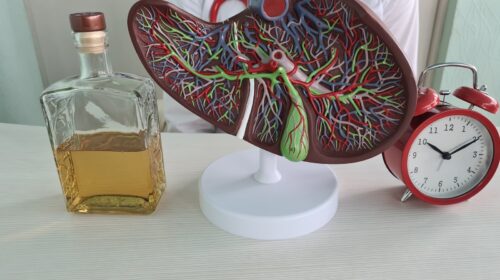A single dose of molly (aka ecstasy) should last 3 to 6 hours. However, adverse side effects could persist for up to a week after the initial dose. Long-term physical and psychological problems have been documented due to ecstasy use.
What is Molly?
Molly (aka ecstasy or MDMA) is the street name for an amphetamine derivative popular at clubs, raves, and concerts. While it is a derivative of amphetamine, ecstasy contains properties of mescaline– the active hallucinogenic ingredient in peyote cacti.
The effects of ecstasy are a combination of the effects of amphetamines and hallucinogens.[1]
Euphoria, along with hallucinations, are experienced by ecstasy users. However, since it resembles both classes of drugs, ecstasy users can experience the “crash” of amphetamines along with hallucination perception persisting disorder (HPPD) of hallucinogens.
Long-term physical problems such as jaw clenching and tooth grinding have been reported, as well as long-term psychiatric problems such as memory impairment and HPPD.[2]
History of Molly
First synthesized in 1912, ecstasy was patented over the years as a cough suppressant, tranquilizer, and appetite suppressant in 1956, 1960, and 1961, respectively.[3] It never ended up getting marketed for any of these purposes.
Nowadays, ecstasy is used exclusively nonmedically. Most countries worldwide prohibit the possession, distribution, and use of ecstasy.
Molly’s Mechanism of Action
Ecstasy primarily increases the release of serotonin and noradrenaline and, to a smaller extent, dopamine[4]:
Serotonin
Serotonin mediates our experience of cheerfulness, positivity, and even wakefulness. It naturally follows that people who use ecstasy report happiness and sociability.
Ecstasy follows a similar mechanism of action to SSRI medications: It blocks the reuptake of serotonin into the cells around it. This leaves more serotonin available to achieve a greater experience of serotonin’s effects.
Noradrenaline
Noradrenaline mediates our experience of general arousal, focus, cognition, and stress. It’s naturally released during a flight/fight/freeze event when your body needs to respond to a stressful event.
Dopamine
Dopamine mediates our experience of pleasure. During healthy activities such as eating, drinking, exercise, and sex, your central nervous system signals your brain to release extra dopamine. It attaches to dopamine receptors to produce feelings of pleasure to reward you when the activity is repeated.
Why Do People Use Molly?
In 2021, 0.8% (2.2 million people) of the US population over the age of 12 reported using ecstasy in the past 12 months. People use MDMA at clubs, raves, and concerts as a party drug because it enhances wakefulness, physical stamina, sociability, and sexual arousal.[5] It helps them dance and be happy for hours on end. This environment can be dangerous for multiple reasons:
Rise In Body Temperature (Hyperpyrexia)
One documented side effect of MDMA is a rise in body temperature.[6] Unlike your skin, which can withstand massive swings in temperature, your body’s organs are very sensitive to even a shift of a few degrees in temperature. A slight temperature rise could cause permanent damage to your organs (heart, lungs, etc).
Using MDMA in a hot club exacerbates its hyperpyretic symptoms, and many documented cases exist of ecstasy users dropping dead due to severe hyperthermia.
Low Sodium Levels (Hyponatremia)
Another documented physical side effect of MDMA use is a sodium level below normal (hyponatremia).[7] Profuse sweating due to a higher-than-normal body temperature in a hot club will cause the body to lose copious amounts of salt.
If you compensate for this by drinking a lot of water, it will dilute the salt left in the blood. If this cycle continues for long enough, seizures and respiratory depression can occur. Losing copious amounts of salt combined with dilution by water can cause fatal respiratory depression, which has been documented in many cases of MDMA use.
Sexual Arousal
While people do use MDMA to be more social, it can also have the secondary effect of decreasing their sexual inhibitions. This can increase the possibility the user will engage in unsafe sex practices like not using condoms or ignoring internal warning signs about unsafe sexual partners.
Using MDMA in a crowded club can increase the chance of contracting STDs or experiencing nonconsensual rape.
How Long Molly Lasts

MDMA’s effects generally last around 3 to 6 hours.[8] It will reach its peak plasma concentration within 2 hours of dosing. Peak blood concentrations for normative doses of MDMA could range between 106 ng/mL (50mg dose of ecstasy) and 236 ng/mL (125mg dose of ecstasy).[9]
The half-life of ecstasy is 8 hours.[10] Users often follow the initial dose with a follow-up dose right as the desired effects start to wane. This allows them to continue experiencing the effects of ecstasy and put off the “crash” until the next day.
An elimination half-life is how long it takes 50% of a substance to be eliminated from the body. It takes 4-5 elimination half-lives to statistically eliminate a substance from the body (<95%). It can take anywhere from 32 to 40 hours to eliminate ecstasy from the body.
Primates who were given ecstasy doses were found to have altered serotonergic neurons even when tested seven years later.[11]
Non-Threatening Side Effects of Molly Use
Some of the desired effects of ecstasy include[12]:
- Euphoria
- Cheerfulness
- Greater focus
- Heightened sociability and sense of closeness to others
- Greater tolerance to the opinions, views, and feelings of others
Some mild, non-threatening effects of ecstasy include[13]:
- Headache
- Muscular tension
- Nausea
- Loss of appetite
- Teeth grinding
- Blurred vision
- Dry mouth
- Restless legs
- Racing thoughts
- Insomnia
After the “crash,” the most commonly reported side effects are difficulty concentrating, depression, anxiety, and tiredness. Most new users find the positives more powerful than the negatives, but with sustained usage, tolerance to MDMA builds, and the adverse effects become more pronounced.[14]
Dangerous Side Effects of Molly Use
While it’s generally touted as a safe drug, there are well-documented serious adverse events associated with ecstasy use.
Ecstasy concentrates serotonin in the synapses. But at massive doses, serotonin becomes a neurotoxin that damages the neurons that released it.[15] One post-mortem study of a long-term ecstasy user found that serotonin levels were reduced by 50-80% in different brain areas, suggesting that too much short-term serotonin, while pleasurable, kills your ability to experience the long-term benefits of serotonin.
Some of the more serious long-term psychiatric problems of MDMA use include:[16]
- Degraded memory
- Impaired decision-making, reasoning, processing, and problem-solving
- Impulsivity
- Panic attacks
- Paranoia
- Depersonalization
- Hallucination Perception Persisting Disorder (HPPD)
- Severe depression
- Suicidal thoughts
Some of the more serious physical problems of MDMA use include:[17]
- Jaundice
- Liver injury
- Irregular heartbeats
- Heart failure
- Eye damage
- Organ damage due to hyperpyrexia
Treatment For Molly Addiction
MDMA use can form a dangerous psychological addiction. If you are addicted to ecstasy, seek treatment immediately. Look for an accredited treatment center with an expert team of addiction professionals, evidence-based therapies, and a supportive community to live out your recovery.
Recovery Unplugged a network of treatment centers stretching from Texas to Virginia, easily in reach of millions of Americans. We utilize the natural connection we all have with music to help you embrace evidence-based therapies to get you back on your feet.
Keep Your Chin Up
Some days, it can seem pretty hopeless. But there is ALWAYS hope. hat you have ahead of you is nothing compared to what you have inside of you. If you’re addicted to ecstasy, you can regain control of your life by seeking treatment. No matter how scared or terrified you are, there are people nearby who want to help you on your recovery journey. Contact us today to learn more about treatment and support.

























